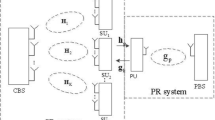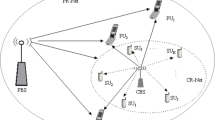Abstract
The cognitive radio multiple-input multiple-output Gaussian broadcast channels are studied where multiple antennas are available for both primary users and secondary users in a spectrum sharing environment, and the sum-rate capacity is also obtained under both the SUs’ transmit power constraint and interference power constraint at the primary receivers. The paper principally consists of two steps. First, a duality technique and dirty paper coding are adopted to simplify the channels. Second, we propose an iterative power allocation algorithm to obtain the maximum sum-rate capacity and examine the effects of the constraint parameters on the concerned quantities. Finally, numerical simulation results are presented to validate the proposed theoretical analysis.
Similar content being viewed by others
References
Hong X., Chen Z., Wang C. X., Vorobroy S., Thompson J. S. (2009) Cognitive radio networks: Interference cancellation and management techniques. IEEE Vehicular Technology Magazine 4: 76–84
Choi K. W. (2010) Adaptive sensing technique to maximize spectrum utilization in cognitive radio. IEEE Transactions on Vehicular Technology 59: 992–998
Wang C. X., Hong X., Ge X., Cheng X., Zhang G., Thompson J. S. (2010) Cooperative MIMO channel models: A survey. IEEE Communications Magazine 48: 80–87
Xiao H. -L., Ouyang S., Nie Z. P. (2010) Design and performance analysis of compact planar inverted-L diversity antenna for handheld terminals. Wireless Personal Communications 52: 709–718
Diaz J., Simeone O., Bar-Ness Y. (2008) Asymptotic analysis of reduced-feedback strategies for MIMO gaussian broadcast channels. IEEE Transactions on Information Theory 54: 1308–1316
Al-Naffouri T. Y., Sharif M., Hassibi B. (2009) How much does transmit correlation affect the sum-rate scaling of MIMO Gaussian broadcast channels?. IEEE Transactions on Communications 56: 562–572
Wang C., Hong X., Chen H. H., Thompson J. (2009) On capacity of cognitive radio networks with average interference power constraints. IEEE Transactions on Wireless Communications 8: 1620–1625
Lee S. H., Thompson J. (2010) Trade-off multiplexing streams in MIMO broadcast channels. IEEE Communications Letters 14: 115–117
Gao F., Zhang R., Liang Y. C., Wang X. D. (2010) Design of learning based MIMO cognitive radio systems. IEEE Transactions on Vehicular Technology 59: 1707–1720
Yin H., Liu H. (2002) Performance of space-division multiple-access with scheduling. IEEE Transactions on Wireless Communications 1: 611–618
Zhang R., Liang Y. C. (2008) Exploiting multi-antennas for opportunistic spectrum sharing in cognitive radio networks. IEEE Journal of Selected Topics in Signal Processing 2: 88–102
Scutari G., Palomar D. P. (2010) MIMO cognitive radio: A game theoretical approach. IEEE Transactions on Signal Processing 58: 761–780
Gomadam K. S., Jafar S. A. (2010) Duality of MIMO multiple access channel and broadcast channel with amplify and forward relays. IEEE Transactions on Communications 58: 211–217
Soundararajan, R., & Vishwanath, S. (2008). Adaptive sum power iterative waterfilling for MIMO cognitive radio channels. IEEE international conference on communications (pp. 1060–1064). Beijing, China.
Jafar S. A., Shamai S. (2008) Degrees of freedom region of the MIMO X channel. IEEE Transactions on Information Theory 54: 151–169
Peng Y., Rajan D. (2010) Capacity bounds for a cognitive MIMO Gaussian Z-interference channel. IEEE Transactions on Vehicular Technology 59: 1865–1876
Kang M. S., Jung B. C., Sung D. K. (2008) A pre-whitening scheme in a MIMO-based spectrum-sharing environment. IEEE Communications Letters 12: 831–833
Liang X. B. (2008) An algebraic, analytic, and algorithmic investigation on the capacity and capacity-achieving input probability distributions of finite-input-finite-output discrete memoryless channels. IEEE Transactions on Information Theory 54: 1003–1023
Zhang L., Xin Y., Liang Y. C. (2009) Weighted sum rate optimization for cognitive radio MIMO broadcast channels. IEEE Transactions on Wireless Communications 8: 2950–2959
Lu P., Yang H. C. (2010) Sum-rate analysis of multiuser MIMO system with zero-forcing transmit beamforming. IEEE Transactions on Communications 57: 2585–2589
Author information
Authors and Affiliations
Corresponding author
Rights and permissions
About this article
Cite this article
Xiao, HL., Ouyang, S. & Wang, CX. Cognitive Radio MIMO Gaussian Broadcast Channels with the Power Constraint. Wireless Pers Commun 68, 769–778 (2013). https://doi.org/10.1007/s11277-011-0481-6
Published:
Issue Date:
DOI: https://doi.org/10.1007/s11277-011-0481-6




